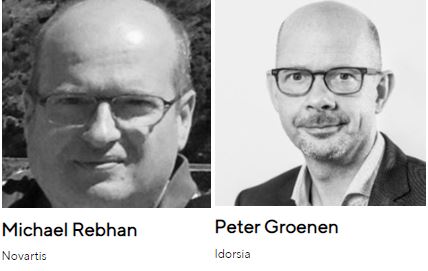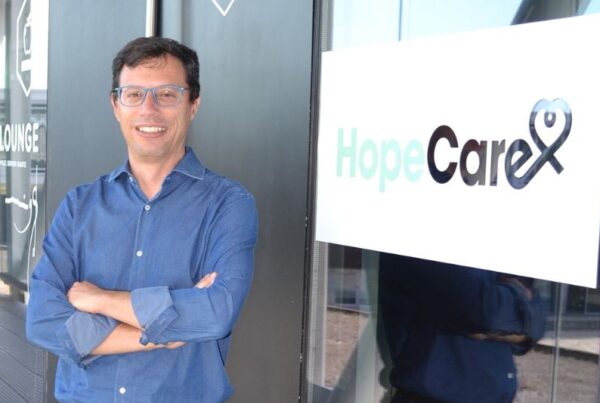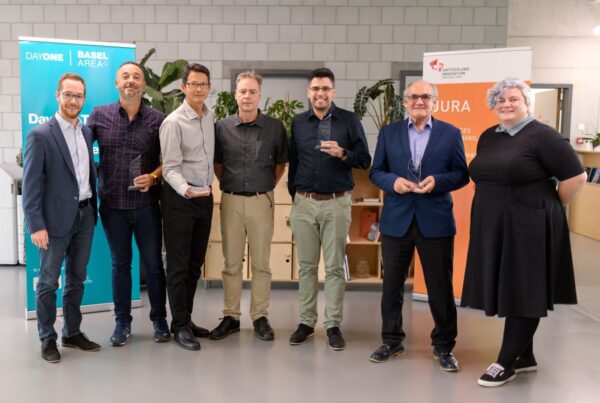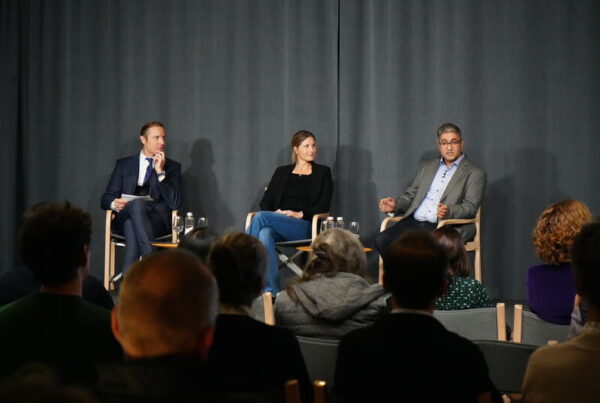Featured Interview

DayOne started five years ago and has grown into a community with over 2000 active healthcare innovators. Among the very first initiators were Michael Rebhan, Novartis, and Peter Groenen, Idorsia. In this interview they reflect on how it all started, what has been achieved so far and what is to come.
Q: Michael, what we call DayOne today started with a workshop you organized back in 2015?
Michael Rebhan: Is that already five years ago! I don’t even remember the topics we discussed. This shows how much has changed since then.
Peter Groenen: I remember that a colleague showed me Michaels invitation and said: this is something for you. I looked at the program and thought, this is unusual. And so it was, at the workshop I met a group of people talking about things I was totally not used to since I have been looking at Precision Medicine and personalized health from a molecular point of view. Now we were talking about patient centricity, healthcare systems, digital biomarkers and about data, data, data. This was inspiring although I am known to be critical and sceptical to hypes. Actually, I think this is one of the strengths of DayOne, we never got caught up in hypes and were able to maintain an honest view on things.
Michael Rebhan: You touch on something very crucial here. The honesty of the people that were there or that have followed DayOne since is really something special. We always fostered open arguments without preconditions, also – and this is very important – crossing the border of one’s own expertise. Something you don’t always find in a classic, big organization, where things tend to be fragmented, people having well-defined roles with little room, and feel a bit like a small wheel in a huge machine they don’t fully understand. Although currently we experience a certain appetite to change this mind set, as many organizations try to re-invent themselves. I think it is fair to say that DayOne was early in this, and helped people prepare for what’s coming.
Peter Groenen: Especially the second workshop we did at the Lift Basel Conference was somehow a crazy experience for me. Generally, in science we often tend to stick to our beliefs and defend our ideas while here the ability to connect dots showed to be very powerful where 60 people in a room together can come up with 10 sound ideas in just 45 minutes. In a corporate environment this would take months if it would happen at all.
Michael Rebhan: This is what really created the community momentum. Alain Bindels from Roche who joined the group bringing in his design thinking expertise was really crucial in making the next step and bringing ‘connect-the-dots’-mind set to life.
Q: What happened since?
Michael Rebhan: I remember when I first started in science people usually had a more fixed way of thinking about problems, up to the point where they would test a socially dominant hypothesis for decades, before they would pick up seriously on new ideas that were different in approach. This was pretty much the case until recent years, when things started to shift, in terms of mindset, and openness for new ways of doing innovation. Now the dynamics are different, for approaches with less history. People in many institutions are really looking for new models and ways of solving problems. I believe we are experiencing the early stages of a paradigm shift, which happens in parallel in various places, and organizations. This may result in new ways to find solutions for important problems.
Peter Groenen: … which is very much needed. Our industry has reached the end of a cycle. I think all the simplistic approaches to look at health and medicine have been exhausted. People are getting frustrated. We definitively need to think outside of the box. But again, this must be done with the right mind set and not just blindly following the next big thing – because then we only create what I like to call digital snake oil. We have already been there. In the nineties everybody thought genetics and genomics would solve all problems, to our all complete delusion. Not that genetics or genomics are not important, but these are only a few factors among many others to consider.
Q: And now, the digital buzz has taken over from the genetics buzz?
Michael Rebhan: I would actually not emphasize the digital buzz too much. I think the true driving force is patient centricity, in a broad sense. Starting with the patient’s point of view, you will recognize the complexity of what we are dealing with and of course then you must reach out to digital technologies in order to get hold of this complexity. We may be able to learn a lot from more “customer-centric” industries as well.
Peter Groenen: I agree. If you think about it, most of all it is the personal data of patients that unveil new insights, and also brought in the new players like Google, Apple or Amazon.
Q: What has DayOne achieved so far?
Peter Groenen: I would say, it’s a great starting point, but we still have to deliver on the promise. When you are looking at the mission statement of DayOne it’s all about collaboration between the essential disciplines and players in the Basel ecosystem.
Micheal Rebhan: For the avant-garde in the field, Basel was very much considered too much “old school” in culture. Some of these pioneers think of Basel differently now, they believe it’s a place that has potential and is worth staying. For me this is a big achievement, as we need people who challenge the status quo. Also, since DayOne is here, a lot of things in the region have been initiated. I am not saying that they directly came out or were controlled by DayOne, but surely there has been some contribution to this, by catalysing around mind set, honesty, energy, key questions, and new ways of innovating and co-creation in diverse groups.
Peter Groenen: I agree, but if we want to stick to our mission, we still haven’t achieved the main goal. We might have contributed to creating more dots, but the dots are not yet connected. I think connecting the dots rather than creating new dots makes the difference. This wisdom should not get lost down the road as the initiative gets more and more attraction.
Q: Which dots are to be connected next?
Peter Groenen: Compared to other hubs like the Boston area, specifically the flow between fundamental, biomedical science and industry research has to be improved. The medical community and the (industrial) research community here are still very separated. We would need more people in between. In Boston and other places there literally meeting places where people cook up new ideas with all relevant stakeholders within a square mile.
Q: If we look at healthcare in the last 20 years – how successful has the industry been?
Michael Rebhan: If we look at the past 50 or 100 years, we can say our industry has been very successful, at the population level. But this is actually the dilemma we are facing. Because of this overall success it is hard to question the status quo. Why would you want to change a winning horse? If we take a real honest look at what science is working on compared to what really reaches the healthcare system, it’s pretty much clear that our ability to translate innovation to patient impact only works in some areas, but not in others. There are many translational challenges.
Q: My insurance bill increases every year – do I really get more for my money?
Peter Groenen: Usually the increase in life expectancy is what we use to measure the overall success for healthcare. In this regard, the answer is clearly, yes, healthcare is successful, although not everywhere in the world, healthcare as we know it is a privilege of the developed Western world, not the for the developing countries who don’t or only have limited access to it. But the troubling question is: Could it have been better? My answer to that is yes. The system is too inefficient, not only concerning drug efficiency, which is carefully measured, but most of all regarding medical intervention, which often enough do not deliver the promised outcome. Overall, unfortunately, the healthcare system is known to be rather inefficient and the process of improvement too slow.
Michael Rebhan: As an industry with much history we are naturally focused on the operationally doable. This basically means: everything we do, in terms of medical innovation, has to be squeezed into to the clinical trial paradigm for evidence generation, to build the scientific foundation for good decision making. But not all medical needs fit well into this paradigm. And these are accumulating and causing stress at system level. This includes patients who are often excluded from clinical trials, or complex multi-morbidity. Change in this perspective is not a trivial thing, if we want to build on good science. Digitalization opens new possibilities here, at increasing speed, but we need time to build a solid scientific foundation for decision making in areas where the current model of evidence generation is only of limited help.
Q: Will digital solutions be able to fill the gap where the current paradigm has failed?
Michael Rebhan: I think we are still in a hype that is primarily driven by technology excitement, and not by a clear problem definition. We need more problem-centric innovation models that tap into technology where it helps, rather than the other way around. I am convinced that in the next four to five years we will see significant progress in this field, generating new innovation platforms and ecosystems that facilitate problem-centric models, on top of the new data economy, and more demanding patients. It is a mental shift, firstly we need to change from a push to a “push and pull” mode in health innovation. Secondly, define problems closely with patients, providers, payers and others, understand the problem, and its dynamics, at population level, and then build the solution together with an evolving ecosystem of participants that play different roles. Currently we are very much used to working the other way around. We create new technologies in the lab, invest in those with the most convincing data, and then push the product to the market. We must learn how to focus more of our time on really understanding medical need, disease burden, high-risk populations, different data and roles, and the problems that do not easily fit into the classic clinical trial paradigm.
Peter Groenen: As patients get more and more involved, I see this change happening. Being able to build in this pull component will really be crucial to achieve further progress in the medical field. It is a lot about bridging the gap between the science community cooking up whatever they think a patient needs, and the real-world challenges that those patients are actually facing.
Michael Rebhan: Take vegan food. I don’t think the big retail chains decided to ship these products into their supermarkets. It was the customers’ need for different products that made them do so, as they scout for new growth areas. I think this is where the future of health will be heading, with the pull factor increasing in the overall innovation mix. For many industries it is self-evident that new products get a lot of end-user input early in the process, but for us that’s not where we come from. So it takes time to get used to a new model.
Peter Groenen: Although it will never get as simple as that. The more sophisticated a technology is, the more you need to translate between what a customer thinks they need and what they really will use. The iPhone is the best example. Nobody would have been able to express the requirements for a smart phone before it was on the market. In healthcare I believe this translational part will be even more challenging, biology is complex and the healthcare process also.
ABOUT THE INTERVIEWEES:
Michael Rebhan is Senior Investigator at Novartis Institute of Biomedical Research and has been a founding member of the DayOne Initiative with a special passion for driving ecosystem innovation.
Peter Groenen is Senior Director and Head of Translational Biomarkers at Idorsia Pharmaceuticals Ltd. and has been a founding member of the DayOne Initiative emphasizing the continuous need to improve collaboration between academic and industrial research and built on previous experiences of hypes.


